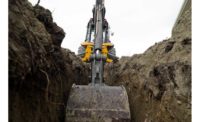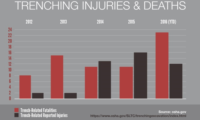A Sauganash, Ill. city water department worker dies after an underground trench collapses around him during a routine project. A man dies after he was trapped in dirt up to his waist while working at a home construction site in Washington State. A Smithton, Pa. teenager dies when the walls of a 10-foot-deep trench collapse on him as he helps install a septic system.
Education, then enforcement
A recent spike in trenching fatalities like the ones described above is behind OSHA’s recent announcement of a renewed effort to prevent such worksite deaths. The agency has updated its National Emphasis Program (NEP) on preventing trenching and excavation collapses and says it will crack down on safety violators – after a three month period of education and prevention outreach.
In addition to the educational effort, OSHA's inspectors will record trenching and excavation inspections in a national reporting system, and each area OSHA office will develop outreach programs.
The agency will step up enforcement efforts through its trenching NEP as of January 1, 2019. Until then, OSHA will continue to respond to complaints, referrals, hospitalizations, and fatalities.
IDing trenching hazards is critical
"Removing workers from and helping workers identify trenching hazards is critical," said Deputy Assistant Secretary of Labor for Occupational Safety and Health Loren Sweatt. "OSHA will concentrate the full force of enforcement and compliance assistance resources to help ensure that employers are addressing these serious hazards."
The agency says enforcement activities will remain in effect until canceled. OSHA-approved State Plans are expected to have enforcement procedures that are at least as effective as those in this instruction.
Safety resources
OSHA has developed a series of compliance assistance resources to help keep workers safe from trenching and excavation hazards. The trenching and excavation webpage provides information on trenching hazards and solutions.



